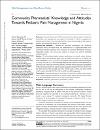Community pharmacists’ knowledge and attitudes towards pediatric pain management in Nigeria
| Author | Ogunyinka, Ibrahim |
| Author | Yusuff, Kazeem |
| Author | Erah, Patrick O. |
| Author | Oshikoya, Kazeem |
| Author | Faponle, Folayemi |
| Author | Ungo-Kore, Hussein |
| Author | Oreagba, Ibrahim |
| Author | Yakasai, Ahmed |
| Author | Idoko, Anthony |
| Author | Ileoma, Solape |
| Author | Umar, Aminu |
| Available date | 2022-04-20T06:14:52Z |
| Publication Date | 2021-01-01 |
| Publication Name | Risk Management and Healthcare Policy |
| Identifier | http://dx.doi.org/10.2147/RMHP.S329387 |
| Citation | Ogunyinka, I., Yusuff, K., Erah, P. O., Oshikoya, K., Faponle, F., Ungo-Kore, H., Oreagba, I., Yakasai, A., Idoko, A., Ileoma, S., & Umar, A. (2021). Community Pharmacists' Knowledge and Attitudes Towards Pediatric Pain Management in Nigeria. Risk management and healthcare policy, 14, 4595–4607. https://doi.org/10.2147/RMHP.S329387 |
| Abstract | Purpose: Community pharmacists (CPs) frequently attend to pediatric patients with pain but limited data exist regarding their knowledge of and attitude to effective management of pediatric pain in Nigeria. Thus, this study aimed to evaluate the knowledge of and attitude to pediatric pain management among CPs in Nigeria. Patients and Methods: A validated and pilot-tested questionnaire, the Community Pharmacists Survey on Pediatric Pain, was administered to 517 eligible participants at the 38th Annual National Conference of the Association of Community Pharmacists of Nigeria. Independent samples t-test and one-way analysis of variance were used for inferential statistical analyses. Results: CPs with additional higher academic qualifications and clinically related additional academic degrees had significantly higher mean knowledge scores relative to first degree only holder counterpart (t= 4.33, p< 0.05, Eta2=0.05) and those without clinically related second degrees (t= 6.34, p< 0.05, Eta2=0.27). Pain knowledge among the study cohort also varied significantly by age group, years of practicing community pharmacy, ownership structure of premises, geographical location of practice and previous exposure to pain management training (F(4370)=2.858, p=0.025, Eta2=0.03; F(3371)=3.985, p=0.008, Eta2=0.03; F(2372)=3.643, p=0.027, Eta2=0.02; F(5369) =4.497, p=0.01, Eta2=0.06; F(2372)=3.587, p=0.029, Eta2=0.02), respectively. Conclusion: Community pharmacists’ knowledge of and attitude to pediatric pain management in Nigeria appeared sub-optimal, and requires regular targeted educational intervention to fill the identified gaps, improve service delivery and patient outcomes. |
| Language | en |
| Publisher | Dove Press |
| Subject | Conference Pain location Questionnaire Referrals |
| Type | Article |
| Pagination | 4595-4607 |
| Volume Number | 14 |
| ESSN | 1179-1594 |
Files in this item
This item appears in the following Collection(s)
-
Pharmacy Research [1208 items ]


